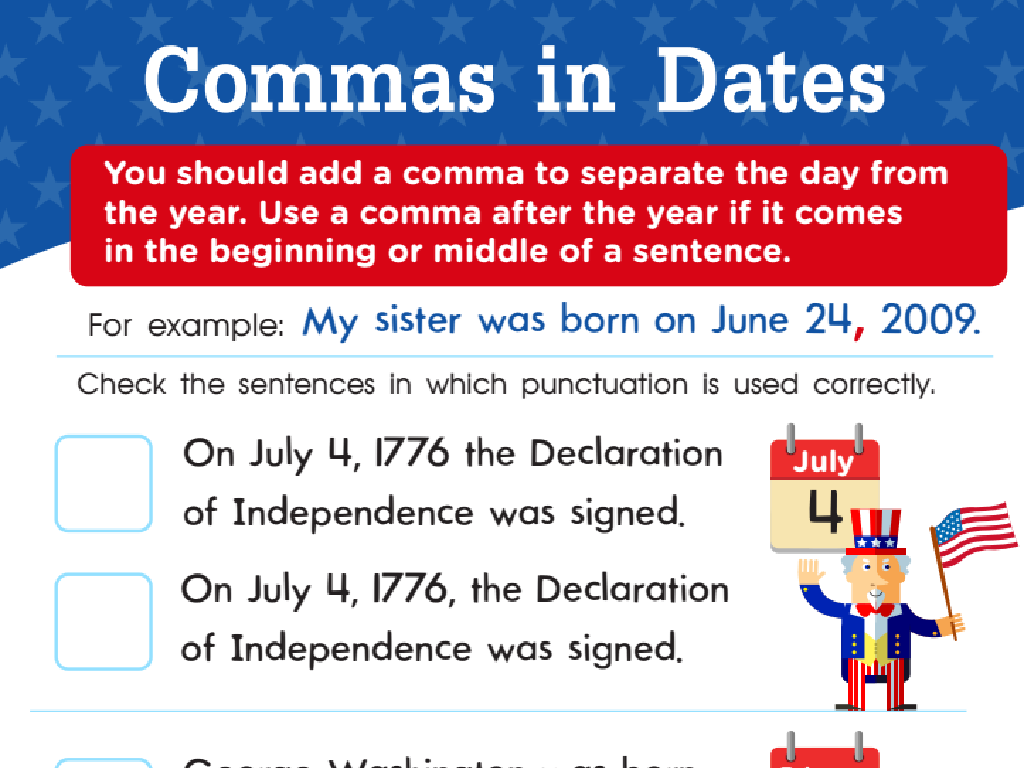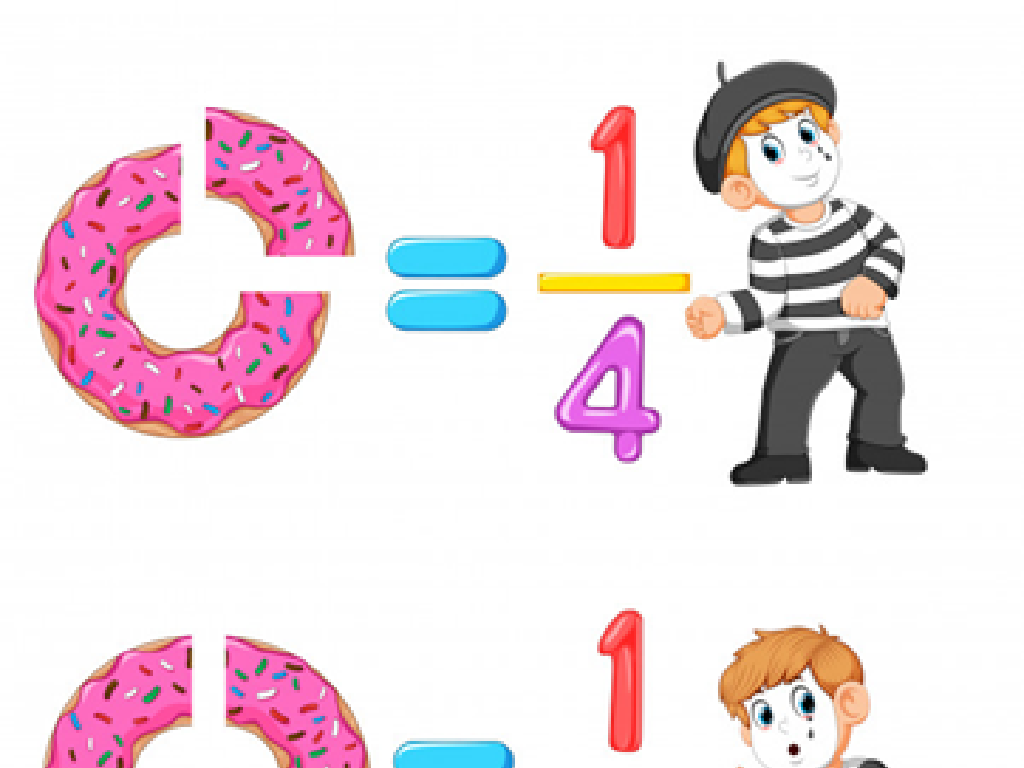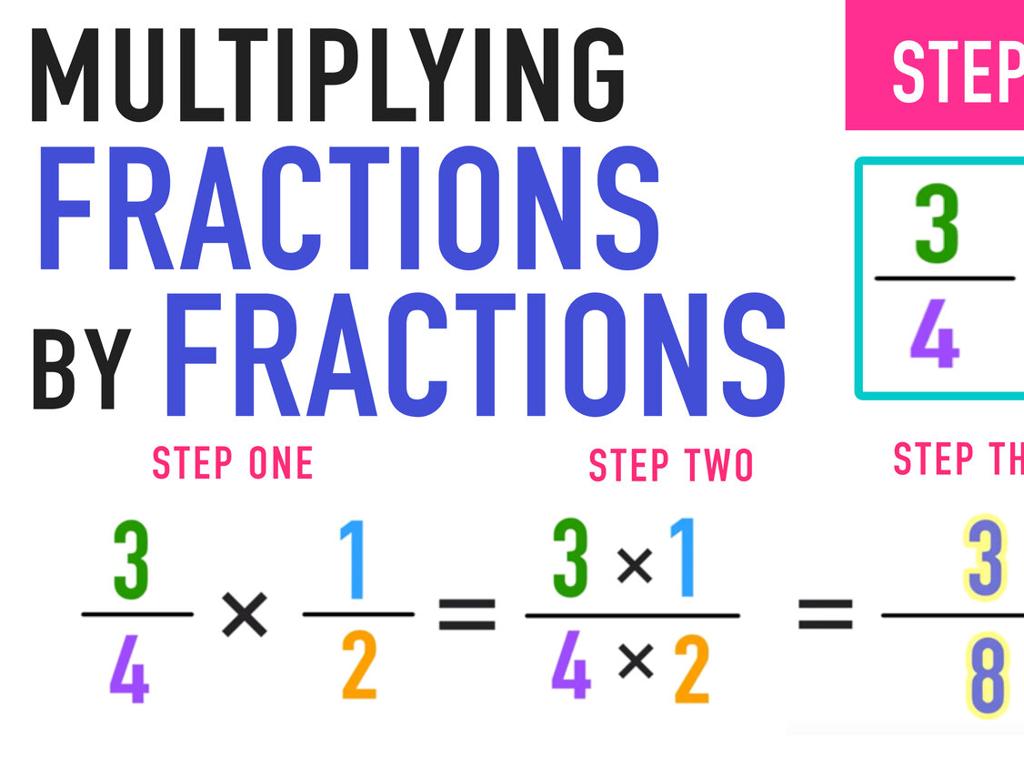Estimate Products And Quotients Of Fractions And Mixed Numbers
Subject: Math
Grade: Seventh grade
Topic: Operations With Fractions
Please LOG IN to download the presentation. Access is available to registered users only.
View More Content
Estimating with Fractions & Mixed Numbers
– Recap: What are fractions?
– Fractions represent parts of a whole, like 1/2 a pizza
– Estimation: Why it matters
– Estimation helps us quickly approximate without exact calculations
– Estimating products of fractions
– Multiply tops (numerators), estimate by rounding to nearest half or whole
– Estimating quotients of fractions
– Divide the numerators, round results for a quick estimate
|
Begin with a brief review of fractions to ensure students recall the basics. Emphasize the importance of estimation as a valuable skill for making quick and reasonable calculations in everyday situations. Introduce today’s objective: learning to estimate the results of multiplying and dividing fractions and mixed numbers. Provide examples of both operations, demonstrating how to round fractions to the nearest half or whole number to simplify the process. Encourage students to think of situations where they could apply these skills, such as cooking or dividing items among a group.
The Power of Estimation with Fractions
– Simplifies complex problems
– Estimation makes tough calculations manageable
– Checks answer reasonableness
– Compare estimates to actual to ensure accuracy
– Saves time on tests
– Quicker than finding exact values, especially under time constraints
– Practical in everyday life
– Useful for quick calculations, like in shopping or cooking
|
Estimation is a valuable skill in mathematics, particularly when working with fractions and mixed numbers. It helps students simplify complex problems by rounding numbers to more manageable figures. This skill is also crucial for checking the reasonableness of answers; if an estimate is far from the actual answer, it may indicate a mistake in the calculation. In test scenarios, where time is limited, estimation can save precious minutes. Moreover, estimation is a practical tool in everyday life, aiding in quick decision-making, such as determining if one has enough money for a purchase or adjusting a recipe. Encourage students to practice estimation with a variety of fractions and mixed numbers to build their confidence and proficiency.
Estimating Products of Fractions
– Round fractions to 0, 1/2, or 1
– Simplify by rounding to the nearest half or whole number
– Multiply the rounded numbers
– Use rounded values to estimate the product
– Example: 7/9 x 4/5
– Estimate 7/9 (approx. 1) x 4/5 (approx. 1)
|
This slide introduces students to the concept of estimating the product of fractions by rounding them to 0, 1/2, or 1 for easier multiplication. Start by explaining the importance of estimation in simplifying complex calculations. Demonstrate rounding fractions to the nearest half or whole number, and then guide students through the process of multiplying these rounded numbers to estimate the product. For the example, show how 7/9 rounds up to 1 and 4/5 rounds down to 1/2 or up to 1, then multiply the rounded numbers to estimate the product. Encourage students to practice with additional examples and to understand that estimation is a useful tool for checking the reasonableness of their answers.
Estimating Quotients with Fractions
– Grasp inverse operations
– Inverse operations reverse effects of each other, like multiplication and division
– Round fractions for division
– Simplify calculations by rounding fractions to nearest whole number before dividing
– Example: 5 3/4 ÷ 2 1/3 estimate
– Estimate quotient of 5 3/4 ÷ 2 1/3 by rounding to 6 ÷ 2
|
This slide introduces the concept of estimating quotients involving fractions and mixed numbers. Begin by explaining inverse operations, emphasizing how division is the inverse of multiplication. Highlight the usefulness of rounding fractions to the nearest whole number to simplify division, making it easier for students to estimate. For the example, guide students through rounding 5 3/4 to 6 and 2 1/3 to 2, then dividing the rounded numbers to estimate the quotient. Encourage students to practice this technique with different fractions to become comfortable with estimation.
Estimating with Mixed Numbers
– Convert mixed to improper fractions
– Easier to multiply: 3 1/2 becomes 7/2
– Use benchmarks for estimation
– Round to 0, 1/2, or 1 for quick estimates
– Example: Estimate 3 1/2 x 2 2/5
– 3 1/2 approx. 3 and 2 2/5 approx. 2, estimate 3 x 2
|
When estimating products and quotients with mixed numbers, converting to improper fractions can simplify the process. Teach students to multiply the whole number by the denominator and add the numerator. For quick estimations, use benchmarks like 0, 1/2, or 1 to round the numbers. For example, to estimate the product of 3 1/2 and 2 2/5, we can round 3 1/2 to 3 and 2 2/5 to 2, then quickly estimate the product as 6. This method provides a way to estimate without complex calculations, which is particularly useful in checks for reasonableness or when precise calculations are not necessary.
Class Activity: Estimation Relay
– Form teams for estimation challenge
– Solve fraction estimation problems
– Use rounding to estimate products/quotients
– Present your team’s estimates
– Share methods and reasoning with class
– Discuss estimation strategies
– Compare strategies: rounding vs. benchmark fractions
|
This activity is designed to promote teamwork and enhance students’ understanding of estimating with fractions and mixed numbers. Divide the class into small groups and provide each team with a set of estimation problems involving multiplication and division of fractions and mixed numbers. Encourage students to use rounding or benchmark fractions to estimate. After solving, each team will present their estimates and explain their approach. Facilitate a class discussion to compare different strategies and highlight the benefits of estimation in practical scenarios. Possible activities: 1) Estimating costs of grocery items, 2) Estimating distances in a relay race, 3) Estimating time needed for homework assignments, 4) Estimating outcomes of recipes with altered ingredient amounts.
Estimation Mastery: Practice Problems
– Work on problems individually
– Share your estimates and solutions
– Discuss challenges in groups
– Talk about where you got stuck and how you solved it
– Reflect on estimation strategies
– Think about how estimation helped in solving the problems
|
This slide is designed to engage students in active practice of estimating products and quotients of fractions and mixed numbers. Students should work on the provided practice problems individually to apply their understanding of estimation in operations with fractions. Afterward, they will share their estimates and solutions with the class to foster a collaborative learning environment. Encourage group discussions to address any challenges faced during the practice. This is an opportunity for students to learn from each other and clarify misunderstandings. Finally, have students reflect on the strategies they used for estimation and how these strategies aided in solving the problems. The teacher should circulate the room, provide guidance, and ensure that each student is participating in the discussions.
Wrapping Up: Estimation with Fractions
– Review estimation strategies
– Understand practice significance
– Regular practice solidifies understanding
– Homework: Estimation Worksheet
– Worksheet focuses on estimating products and quotients
– Be prepared to discuss solutions
– Ready to review answers in the next class
|
As we conclude today’s lesson on estimating products and quotients of fractions and mixed numbers, it’s crucial to recap the techniques we’ve learned. Emphasize the importance of practice in mastering these concepts. For homework, students are assigned an Estimation Worksheet to reinforce their skills. Encourage them to attempt all problems and remind them that we will review the solutions in our next class, fostering a prepared and engaged learning environment. This exercise will help students build confidence in their estimation abilities, which are essential for their future math endeavors.






